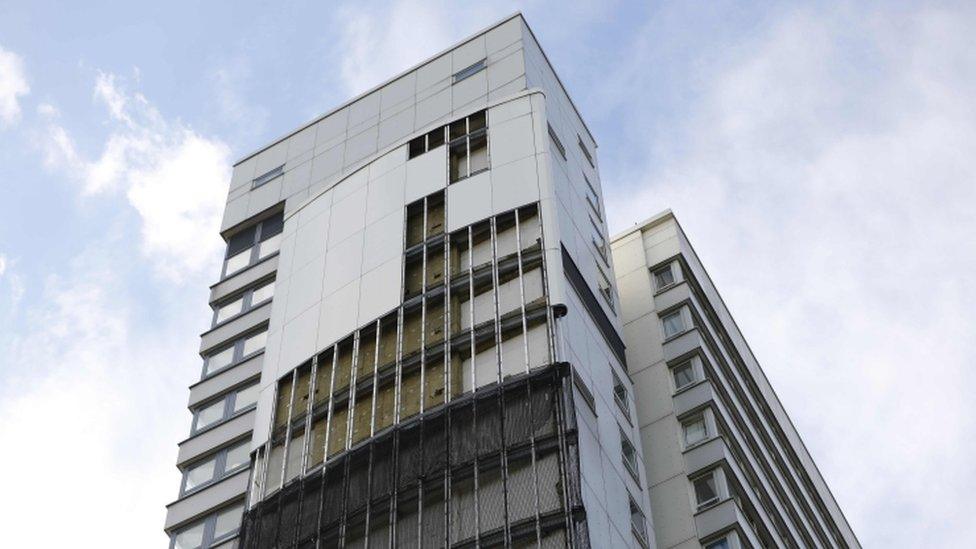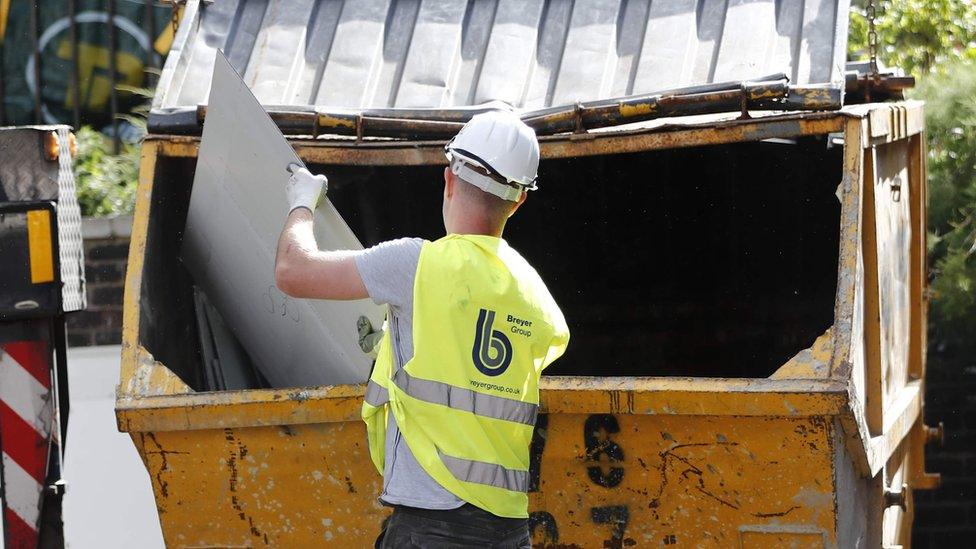What next for buildings with flammable cladding?
- Published

A tower in Islington missing a portion of its cladding
The government is conducting a new series of tests to try to establish how worried it ought to be about cladding on tall buildings and their vulnerability to fire. These tests are very important - and might lead to a smaller number of buildings being deemed to be unsafe than the recent reports seem to suggest. Maybe not, though. We do not know.
These new tests are going to be big: scientists will monitor what happens to a large-scale mock-up of the cladding used on the Grenfell Tower wall, and five other configurations of cladding. There were surely wide-ranging problems at Grenfell, but the exterior of buildings remain a major concern for officials: the fire in Kensington moved swiftly across the outside of the building.
To date, the government has sought to identify other buildings clad in a layer of aluminium composite panels that have a polyethylene (plastic) core - the type of outer skin that was installed at Grenfell. They are also concerned about buildings installed with panels that are merely "fire retardant" - a similar, but slightly more fire-resistant, category of panel.
To be deemed safe by the government's tests, the cladding should be of "limited combustibility", meeting a fire safety standard known in the jargon as "A2". So the tests so far have focussed on working out which buildings have which types of aluminium panels. And, so far, they have identified 181 buildings whose aluminium panels do not meet the A2 standard.
But it is still not clear how we should interpret those results. Not all of those buildings will be dangerous. That is because the fire resistance of buildings' exteriors will not just be a function of the outer skin. For example, it also matters how developers install fire breaks and whether the material immediately underneath the skin was combustible. That's why we need these big tests.
Looking under the skin
At Grenfell, the aluminium sat above a layer of Celotex RS 5000 insulation, which is combustible. That surely contributed to the heat and spread: there is a lot more combustible material in any given layer of insulation than in the aluminium panels. It is possible that if the same aluminium panels had been installed on top of A2 insulation, things might have turned out differently.
For example, there was a major fire in Camden in 2012 in a high-rise where polyethylene-core cladding was installed. In that case, the fire did not move and the fact that the insulation there was non-combustible may have been what stopped the fire becoming more serious.

So we really need to establish how worried we should be about which parts of the wall systems.
Hence, the Department of Communities and Local Government has commissioned these new tests, which will entail rigging up a nine-metre-tall demonstration wall with "a complete cladding system - including panels and insulation - fixed to it, and then subjecting it to a fire that replicates a severe fire in a flat breaking out of a window and whether it then spread up the outside wall".
This does not mean they are going to commission such a test for each building. Instead they will do six tests to cover a range of scenarios. They will use the three common types of aluminium composite material panels: non-combustible panels, fire retardant panels and panels with a polyethylene core. And each one will be tested twice - once with non-combustible insulation and once with combustible.
They may end up doing more: for example, there are several types of combustible material which may behave differently, and it really matters how the insulation is installed. The size of the insulation layer, for example, matters, as does the firebreaking (barriers within buildings that fire cannot cross).
But the ambition is to start working out how safe or unsafe these configurations are. You might well wonder how it can be that, weeks after a major fire, we do not know how many tall buildings have unsafe cladding. To understand why, though, it is worth going back a step.
How buildings get approved
There are, in effect, three big routes to get sign-off on cladding that matter.
First, you can stick to the simple rule book. That means insisting that every major component in the exterior wall meets the so-called A2 standard. That means all the component parts should be of "limited combustibility", meaning - in effect - they won't catch or spread fire.
Second, you can conduct a "fire test". That means rigging up a wall with your proposed wall system, then watching to see what happens in a fire. That is what the government is doing, and is a means of checking whether it is safe to use a few combustible components in your fire system if they are installed in a certain way.
Third, you can commission a fire engineer to write a report arguing for your system without tests. The principle here is that you might not have done proper testing on your exact plans, but there is fire test data relating to a configuration that is very similar.
One of the problems we have already explained is that third route. The so-called "desktop studies" can sometimes rely on very dissimilar test types. We have revealed cases where aluminium panels had been signed off based on tests using ceramic tiles - a very different sort of material. So some combustible cladding may have been installed without ever being tested.

The studies appear to be routinely commissioned by the companies who make the materials under assessment, and are only released by those sponsors when they want to release them. The fact that they are confidential means that the scale of the problems posed by these studies is unclear. But they are clearly of far greater significance and scale than had been previously appreciated.
Newsnight has revealed how one of the bodies that supplies building inspectors issued guidance stating they would sign off B-grade insulation paired with B-grade panelling without even a desktop study. This body, the NHBC, justified it based on the volume of fire tests and desktop studies that they had seen which argued such a combination would be safe. (They have now withdrawn that guidance.)
What happens now?
The government's large-scale tests will have practical effects on any cladding systems which are not entirely composed of A2 components.
They may reveal that some of the cladding systems using combustible materials are actually safe, because they will have been installed in a manner which means that fire cannot spread. They will, in effect, prove that the judgments in the desktop studies were right.
Conversely, the tests may reveal that a large number of buildings must be stripped rapidly of both insulation and exterior cladding. The government is doing the tests because we do not know. One curiosity of these tests, however, is worth noting.
If any combination of materials fail the tests, it will automatically invalidate any desktop studies which have drawn the opposite conclusion on similar configurations of material.
There are variations, and I paraphrase, but the desktop studies we have seen include language to the effect of the following: "If contradictory evidence becomes available to the test authors, the assessment will be unconditionally withdrawn and the company commissioning the study will be notified in writing. The assessment is invalidated if the assessed construction is subsequently tested because actual test data is deemed to take precedence over an expressed opinion."
So these tests could leave building owners in possession of cladding systems that do not meet fire safety standards - and may find themselves, for example, unable to get them insured. There has been nervousness about whether the government should compel private companies to test cladding on their buildings. But the knock-on effects of these fire tests, via the insurers, could force buildings of all sorts to undergo testing - and dramatic remodelling - on their own.